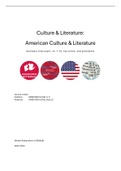Culture & Literature:
American Culture & Literature
Summary final exam: ch. 1-10, key terms, and presidents
Course codes:
Fulltime ENSC3A01X (C&L 3.1)
Parttime ENSFC301X (C&L Visie 2)
Nienke Raaijmakers (1009046)
2022-2023
,Chapter 1: American history up to 1700
America’s Indigenous Peoples
The Indigenous People of America settled relatively late, as Beringia disappeared and North
America could be entered through the Bering Strait around 15,000 years ago. Thus, they arrived
there partly by accident and stayed there partly because it was inhabited. There was grass,
meaning there’d be bisons and they could inhabit it. They did not have a concept of ‘owning’ the
land.
The Indigenous Peoples weren’t all hunters, some of them were farmers. The hunter-gatherers
split into groups/tribes, with their own way of life and customs.
• Nomadic in Plains (teepees, buffalos)
• Seminomadic on East Coast (moving between two locations)
o E.g. Wampanoags (matrilineal)
The terms used for the Indigenous Peoples differs between
context. Christopher Columbus called them ‘Indian’ because
he thought he’d reached India. Many call them Native
American or American Indian. Often, the tribes themselves
prefer to be called by the name of their tribe, as there are many
differences between tribes.
Discoverers
Viking-descent Leif Erikson reached Newfoundland around 1,000 CE.
Columbus’ discovery in 1492 led to European exploration:
• Four voyages to Caribbean.
• Was met there by the Arawak people of Hispaniola.
o Population was decimated: violence, slavery, disease.
The Natives’ culture was often compared to that of the colonizers in terms of historical aspects,
but this also led to ethnocentrism.
Indigenous Peoples’ accomplishments
• Politics: Iroquois Federation.
• Buildings: e.g. Pueblo peoples 1190-1270.
• Advanced farming skills: pollinated and climate adaptation.
o Maize/corn, potato, quinoa, cacao.
, Cahokia: Native Americans’ lost civilization,
hand-made.
When the settlers arrived, they wondered who
made it. Their first theory was the Vikings, their
second theory aliens. They didn’t think of Native
tribes being able to accomplish such a thing.
Age of exploration
1469 Marriage Isabella I x Ferdinand II consolidated lots of Spanish power.
1492 Christopher Columbus’ exploration of the New World. He was Italian, but
sailed under the Spanish flag as the Spanish paid him to search for a new route
to India. He reached the Arawak population, not in what we now call the USA but
in Central America. There was not much to take back to Spain, except for
Arawak people.
Note: Columbus became important after Franklin D. Roosevelt needed voters and promised
the Italian immigrants (who celebrated Columbus Day) to make it into an official federal
holiday. The Italians voted for him because they were treated as second citizens.
1492-1600 The Great Dying: massive loss of lives due to disease brought to America, such
as smallpox. 90% of the population in America (around 56 million) died in this
period. This led to a drop of 0.15°C in global temperature.
1513 First European in Puerto Rico and Florida: Juan Ponce de León.
1539-1542 First European to reach the Mississippi: Hernando de Soto.
1565 First (Spanish) colony in present-day USA: St. Augustine in Florida. This was the
capital of Spanish Florida and founded by explorers named ‘conquistadores’ or
conquerors. The Spanish were already in South America, so going to Central
America was feasible for them.
The Spanish were ‘first’ to settle in the USA: much of what Europeans knew
around colonial time was based on Spanish accounts (golds, riches). Many
followed to travel to the New World: soldiers, priests, merchants.
1607 First English colony: Jamestown.
Export
• Tobacco was very profitable due to nicotine.
• Gold.
• Furs.
, New England
Explorers Pilgrims
1580s Sir Walter Raleigh given permission Pilgrims moved for religious reasons due to
to set up a colony, he delegated this task. laws to punish non-conformists of the
1585 Roanoke colony/the lost colony as Church of England (James I), e.g. Puritans
when John White returned, it was deserted who believed the Church of England should
(poor provisions) base its practices on the theology of Calvin
1587 Chesapeake Bay: attacked by tribes and separatists who believed that a new
due to disease and destruction. church should be formed around Calvin’s
1607 Jamestown: stable, viable, trade. principles.
European indentured servants (work in a 1620 Pilgrims sailed on Mayflower, ended
form of slavery) and African slaves. up in New Plymouth. Mayflower Compact:
democratic political body, first form of
democracy in North America.
Wampanoag Squanto spoke English and
taught the English how to farm (successfully),
harvest led to Thanksgiving in 1621.
Subduction of land.
1692 Salem Witch Trials: not innocent until
guilty, shows the dangers of mass hysteria,
isolation, minority persecution.
New Netherland
The Netherlands was not initially looking to establish colonies in North America, but to find a
quicker route to Asia (too). Expeditions were organized by the Dutch East India Company. Henry
Hudson was the first Dutchman to arrive in North America. The first settlers were lucrative for
trade (Iroquois, Algoquin), which led to definitive settlement.
The Dutch founded New Amsterdam, in which a feudalism system of patroonship was
established. One could become a landlord with ownership of property, laws, and taxes. The
patroon was the lord or the owner of the land.
1652-1674 Anglo-Dutch wars.
These led to loss of New Amsterdam to the Duke of York → New York.
Remnants: places in New York, the word ‘Yankee.’
New France
The French also wanted to find a route to Asia. They mainly engaged in fur trade with the Native
American Peoples.
1534 Jacques Cartier explored the St. Laurence River in Canada and established
trading posts.
1600 France was permanently present in North America. Their problem was that they
had too few people to inhabit the colonized land properly.
The French intermixed with the Indigenous People: many settlers married and had
kids called métis.
1627 Any indigenous Catholic in New France was considered a Frenchman. This was a
way of making good Christians out of them.




